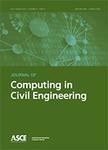版权所有:内蒙古大学图书馆 技术提供:维普资讯• 智图
内蒙古自治区呼和浩特市赛罕区大学西街235号 邮编: 010021

作者机构:Univ Alberta Hole Sch Construct Edmonton AB T6G 2R3 Canada Univ Waterloo Dept Civil & Environm Engn Waterloo ON N2L 3G1 Canada
出 版 物:《JOURNAL OF COMPUTING IN CIVIL ENGINEERING》 (土木工程计算杂志)
年 卷 期:2016年第30卷第3期
页 面:04015039-04015039页
核心收录:
学科分类:08[工学] 0813[工学-建筑学] 0814[工学-土木工程] 0812[工学-计算机科学与技术(可授工学、理学学位)]
基 金:Natural Sciences and Engineering Research Council (NSERC) of Canada Coreworx Inc
主 题:ALGORITHM research INFORMATION storage & retrieval systems INFORMATION technology CONSTRUCTION projects RISK management information systems
摘 要:During a construction project, it is important to ensure that accurate and pertinent knowledge is delivered on time to appropriate personnel. The criticality of documents exchanged or referred to by various parties, evolves over the course of the project life cycle. Determining the criticality of documents at different stages of the project can aid companies with managing the flow of information in an organized manner, while providing for the detection of potentially disruptive, erroneous material that could result in delays and costs. Therefore, it is crucial to determine documents that have the potential to disrupt a process, so that they may be prevented from entering or interfering with the active flow of information in a project. Electronic product and process management (EPPM) systems provide the capability to establish and map information flow between different parties in a construction project. Analyzing an EPPM system may yield information about the criticality of certain documents within an activity, as well as isolate characteristics peculiar to documents, which can assist in risk mitigation. A methodology is proposed to identify such critical documents. Four factors were identified based upon metadata, structure, and historical data recorded for documents within an EPPM system to determine the criticality of documents over a construction project life cycle. The factors and a combined score were calculated for a model project scenario-based simulation within a full-scale EPPM system and anticipated problematic documents were identified. It was therefore functionally demonstrated that determining critical construction documents via document metadata and access history records is feasible and may contribute to both industry and the academic body of knowledge for document classification. (C) 2015 American Society of Civil Engineers.